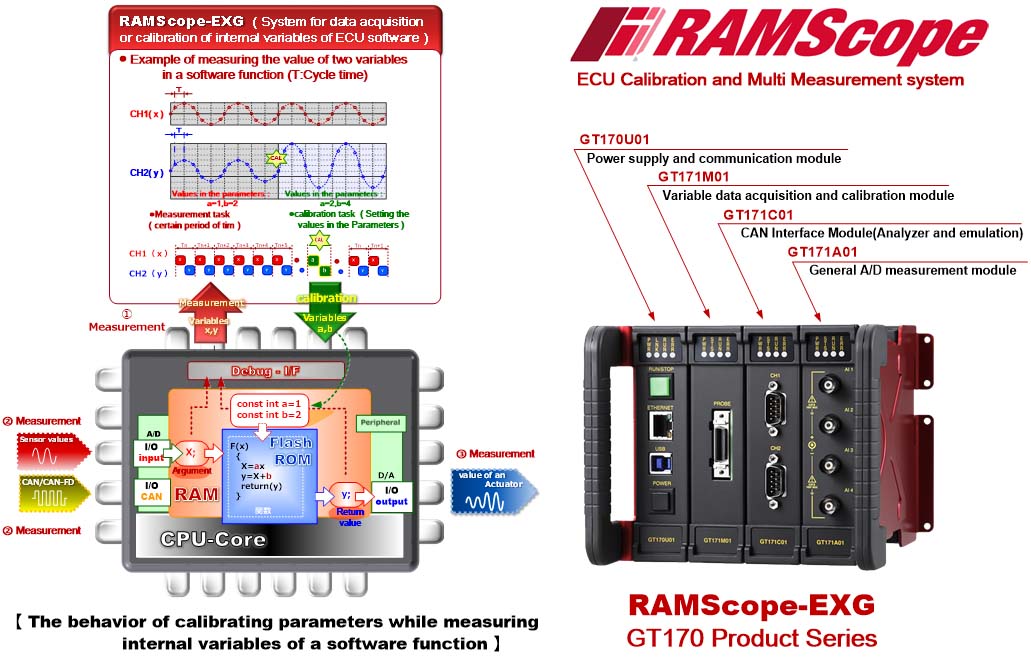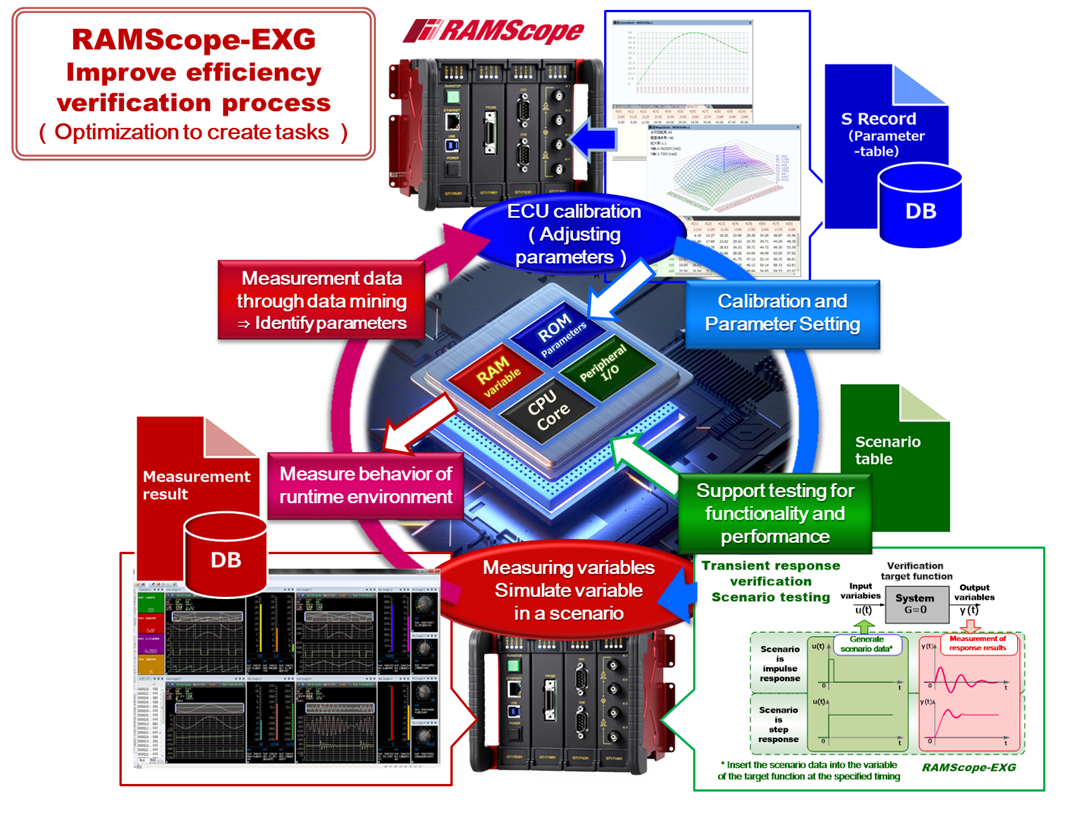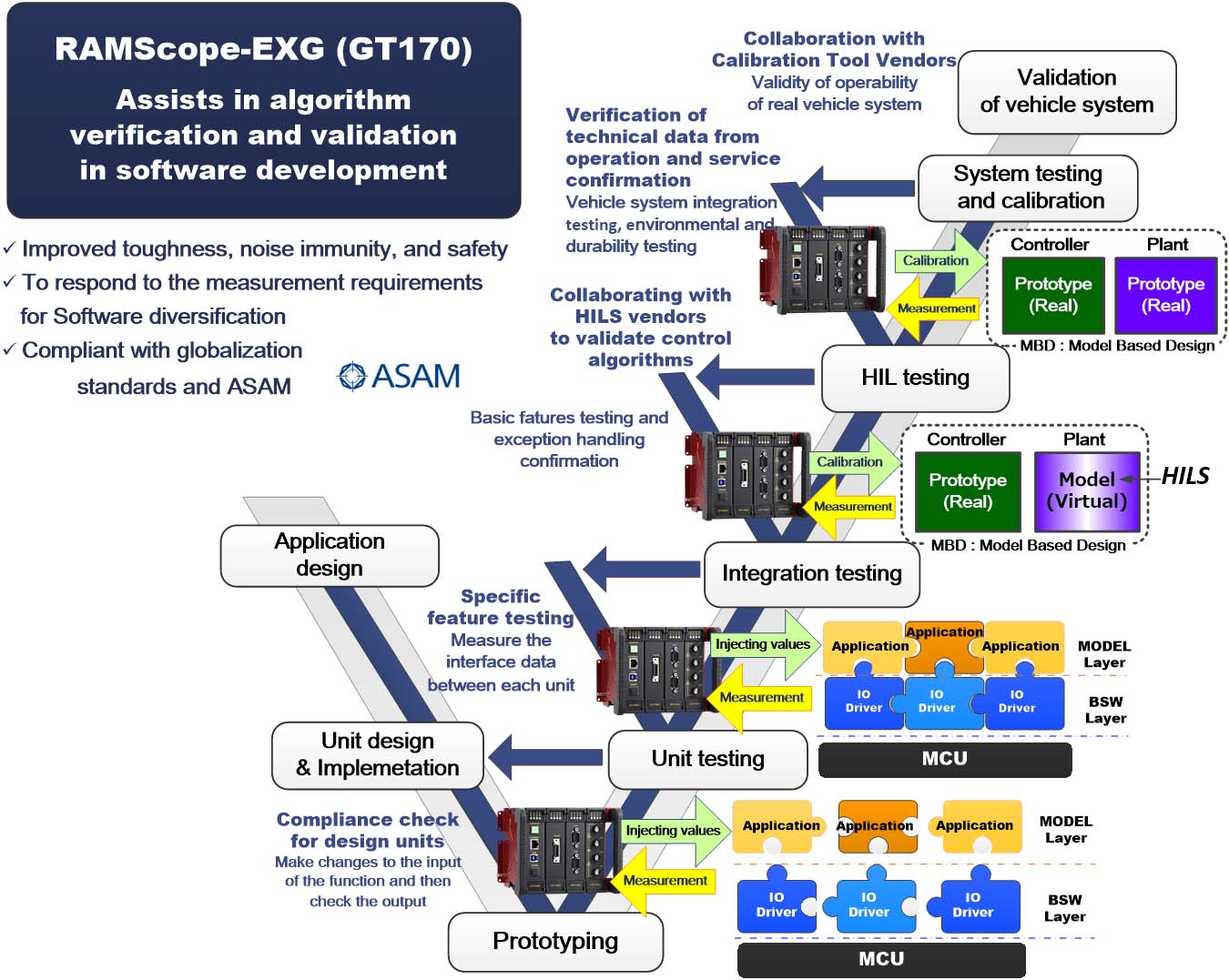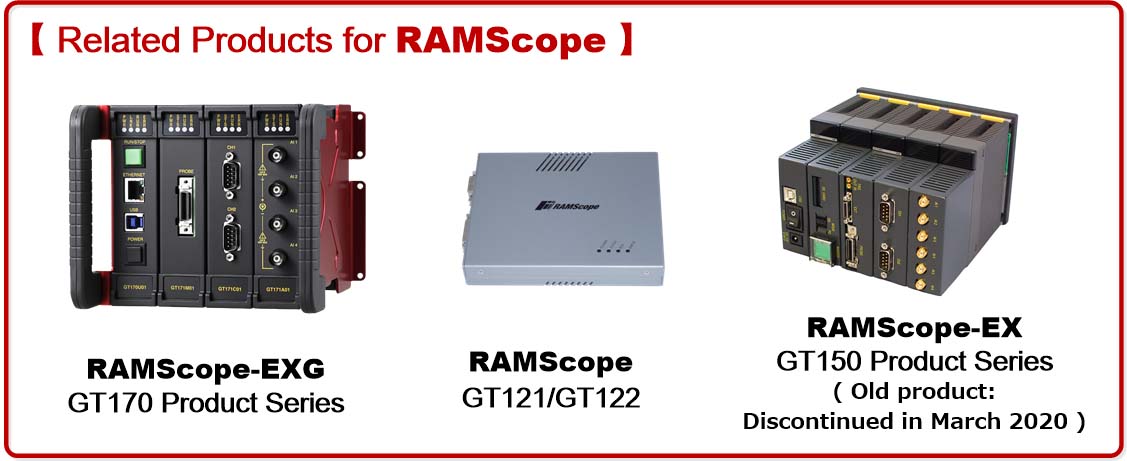RAMScope : Measurement Data Acquisition&Calibration
What are the Challenges of Control Software Verification?
- Does the control software satisfy the requirements specification?
- Are the functions of the embedded control software operating normally?
- Does the processing response keep up with performance requirements?
RAMScope helps solve challenges in the verification process by measuring the behavior of control algorithms
To Measure the Control Behavior (Input/Output Characteristics) of the Control System
- The mass (particle size and quantity) to be measured differs depending on the control target
- Have different measurement goals for different development processes
- Measurement data of Real Target (Product) is desirable as much as possible
Automotive: Powertrain (Engine, EV, BMS), Chassis Control, Driving Safety Support Systems, Body Control
Industrial: Motor Control, Power Control, Machine Tools, Robot Equipment, Office Automation Equipment, Home Appliances
Confirm that the verification results meet the quality requirements.
Unit testing (function: detailed design), Integration testing (function: structural design), system verification (function/performance: product specification),Validation of Requirement Definition(Calibration: Destination Environmental Certification,Reliability and Safety Assurance)
Reduction of defect correction cost (early detection and correction of defects), and outflow of correction leaks and defects
Quality and reliability maintenance : Confirmation of safety measures (failure : performance is lacking, error : mismatch of conditions, fault : emergency stop/abnormal state)
RAMScope contributes to solving challenges in control software verification!
What is RAMScope (Acquisition and Logging of Dynamic Variable Data in Control Algorithms)
Objectives of measuring real algorithm behavior according to control system development requirements:
- Confirm that the system is behaving according to the design specifications (Verification)
- Are the test results of the system behavior that satisfies the requirement definition?(Validation)
- Measure the acceptable range of reliability by changing the environment definition and condition parameters (Estimation)

RAMScope can Visualize the Behavior of Control Models in Real Time
Verification of control system behavior can be determined by observing changes in variable data of algorithms implemented in the control MCU.RAMScope can measure dynamically changing values of control algorithm variables in time series.It is possible to visualize the behavior of function processing and state transitions by measuring the input variable values of the control function and the function output variable values at fixed intervals.

RAMScope (GT170 series) has a lineup of measurement modules that measure analog signals connected to the MCU peripheral interface and communication data of the CAN communication interface.All measurement data are synchronous measurements, including the measurement modules for variable value measurement.It is possible to find the correlation between the variable values inside the algorithm and the signal data of the peripheral IO.
For example, external sensor signals and CAN communication input data connected to the MCU peripheral IO are captured as variables of the control algorithm, and internal data changes are visualized until the actuator is driven via the peripheral IO with the processing results of the internal function.Because it is possible to measure the surrounding environment and MCU internal processing at the same time, it is an optimal tool for verification and validation of control system functions and performance.It also has functions such as control parameter tuning, so it can be used for calibration and measurement for product development that is variant according to environmental specifications.
RAMScope is Equipped with Useful Functions for "Efficiency of Verification Process" and "Ensuring Reliability"
【Proposal to circulate the verification process of the same development environment to improve work efficiency】
In the evaluation and verification of the control model of the MCU embedded system, the function and characteristics are verified by "estimation of control parameters under specific environmental conditions" and "execution of a model implemented system of parameter adaptation".Optimization of control performance requires a cycle of identification work that measures the causal relationship between the input and output of the control model according to the characteristics of the controlled object, and to narrow down the appropriate control parameters from the analysis of quantitative measurement data.
The RAMScope environment supports the tasks of calibrating system parameters, measuring the behavior of implementation models after parameter fitting, and identifying parameters from measurement analysis results.
● Feature Highlights
・Tuning for optimization of control parameters (Calibration)
・Scenario function for automating function verification and performance test
・Observation and measurement of control system behavior, data logging
・View and analyze captured log data along the time axis
・Identify parameters of control model from measurement results
(Refer to the features and functions for details.)

Application Areas of RAMScope in the Product Development Process( Verification and Validation )
In the V-Model process of software development, RAMScope can be used in the "Verification and Verification Phase" from unit test to measurement and calibration of real vehicle tests.
"Improving test coverage" is an important key to ensuring software quality, but early detection of bugs and defects in development deliverables reduces rework, improves development efficiency, and reduces development costs.Verification of software product development is the task of confirming whether the output results obtained from development deliverables that satisfy the required specifications conform to the design specifications and product specifications.
RAMScope enables observation, measurement logging, and calibration of input/output data of the software architecture implemented in deliverables from the initial stage of software development quality verification.RAMScope is widely used for quality assurance step-by-step testing.It is available for the following quality assurance process tasks:
This section introduces an example of use in the quality assurance process of in-vehicle ECU development.: "Unit/integration test", "HIL system test: connecting ECU to HILS virtual plant model", "measurement of real ECU & plant on vehicle, adjustment of final system specifications (calibration)"

Definition of Quality Assurance Process (Verification and Validation) and Benefits of Using RAMScope
【Unit Testing(Debug Operation)】
A unit test evaluates in detail whether the program of the minimum module (functional element) consisting of classes and functions behaves as designed.Since there are a variety of potential fault factors in the function of the unit module after coding, it tends to depend on the experience and skills of the developer whether these faults can be detected without leakage.
In the case of unit testing, the environment construction is insufficient, such as the components of HW/SW that depend on others have not been completed due to the initial stage of implementation.A function test verifies that the output of a function in a module is what is expected from a given input based on a specification.In this case, a test tool (such as a stub) is required to input the "variable: argument" value required by the function, execute the target function processing, and check the "return value" of the processing result.
【Benefits of using RAMScope】
RAMScope can create an environment for functional and behavioral testing of single modules, even on targets under development.In unit tests, it was necessary to incorporate test software to verify the input and output variables of functions, but RAMScope has a function to inject inspection data into input variables and measure output variables during target execution. (Data write by scenario)
By injecting inspection data into the input variables (arguments) of the function under test at specific timings and measuring the output variables (return values) in real time, you can verify the functionality of a single unit.Setting data (values and timing) to be injected into variables for function verification can be registered as a test scenario.Use this function to improve development efficiency, such as automating unit testing.
【Integration Testing(First Stage Verification)】
The integration test verifies whether the interplay between each unit module functions correctly in the component or subsystem that integrates the unit or modules (elements) verified by the unit test.Functional testing that integrates units and modules confirms that interfaces for connecting individual functions operate as designed and verifies that the architectural design is correct.
The function and performance of the component can be verified by observing the data on the connection interface between the integrated units and modules.Integration testing before system testing validates the software design structure.
If the structural design is not sufficiently considered during development, every time a defect is discovered in the test, the unit test is often repeated by correcting the unit module.
【Benefits of using RAMScope】
It is possible to measure multipoint variables contained in multiple units and modules.(Up to 2048 variables can be registered and measured)To reveal interplay dependencies between units and modules, RAMScope allows multi-point instrumentation of variables handled by the interfaces between units and modules.
Please use the test support function(Data write by scenario) when the integration test environment is not ready, such as "units/modules under development cannot be implemented" or "peripheral device drivers cannot be implemented because evaluation has not been completed".
Inject test data into input variables of units/modules to be combined instead of incomplete functions/drivers.It is ideal for measuring the validity of test target logic and response performance.
【HIL System Testing (HILS Validation)】
Early stage system testing of ECU development in automotive applications uses HILS.In automotive applications, model-based development (MBD) is becoming popular.HILS is a virtual hardware environment that replaces the physical plant with a simulation model before connecting the ECU to the vehicle's plant model.
The HIL test integrates the components and subsystems that have completed the integration test, and checks whether the system including hardware (ECU) and software meets the specification requirements.
The physical plant (vehicle parts) to be controlled is replaced with a virtual model, and the specification requirements of the binary software implemented in real-time hardware on the ECU side are verified.Many safety requirements, such as diagnostic functions and fail-safe, are implemented in ECU production software.HILS is an effective environment for verifying abnormal processing systems such as non-design events and non-functional requirements.
System tests before installing an ECU in a vehicle include functions (normal/abnormal), performance (processing speed, continuous operation, load test), application environment (configuration, compatibility, maintenance), etc.
【Benefits of using RAMScope】
In ECU function verification using the HIL system, HILS measures changes in the electrical signals and physical quantities of the input/output interfaces that control the virtual plant model and verifies the appropriateness of control.RAMScope can verify control software by observing and recording the behavior of internal variables of components and subsystems related to plant control interfaces.
The measurement application visualizes the behavior of his ECU internal variables during the HIL system test run, and after the test series is completed, the system behavior can be analyzed using the measurement log.Measurement settings for internal variables such as startup under complex environmental conditions, repetition of instantaneous interruptions, and continuous execution are possible.
The GT170 series complies with the ASAM-XCP standard and can be connected as a slave tool for third-party HILS.Synchronous measurement with HILS is possible by integrating the HILS application software and RAMScope API.
HILS is an effective means of verifying "response to abnormalities" and "fail-safe", which are difficult to reproduce on real-time targets. At the same time, since the behavior of software exception handling can be measured from internal variables, safety and reliability can be further improved.
【System Testing and Calibration】
This is a process to ensure the quality of components and system levels in vehicle test environments and on-road tests in order to finish ECU products to the level of mass production.System tests validate the requirements (function and performance, maintenance service, etc.) of production vehicle systems.
As an overview of the validation of requirements: functions (normal/abnormal systems), performance tests (evaluation of specification data), environmental tests, operation system tests (usability), diagnostic tests, etc. are performed.
In the quality assurance process of ECU algorithms for mass-produced vehicles, calibration is performed to optimize the control parameters.Appropriate calibration is performed for each product variant model and destination.
【Benefits of using RAMScope】
RAMScope is used for variable measurement and parameter calibration of ECU software for mass production in the vehicle test environment and on-road tests.Enhanced operating temperature, robustness, and noise immunity to support all vehicle test environments.
The GT170 series products are compliant with the ASAM-XCP standard and can be linked with calibration and measurement tools made by third parties.It is possible to share the development environment assets owned by the customer.
Our measurement/calibration application tool (RAMScopeVP) conforms to the ASAM standard for configuration of the calibration environment, protocol, measurement data storage format, and tool linkage.
Please use it at the site of various measurements and calibrations.(Compliant with ASAM MCD-1 XCP, MDF/A2L, ASAP 3)

